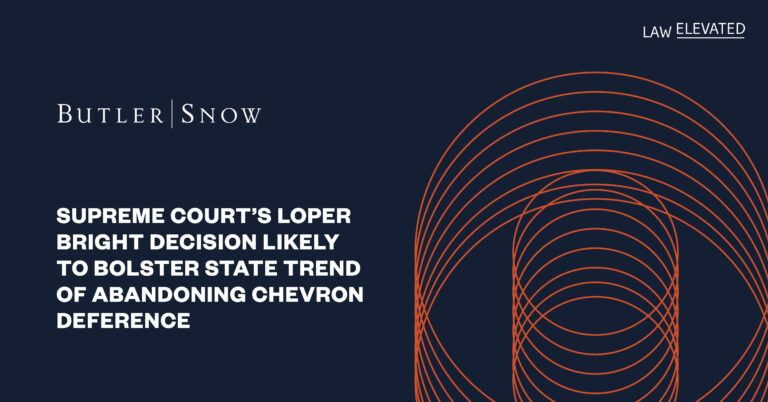In a 6-3 ruling, the United States Supreme Court in Loper Bright Enterprises v. Raimondo,[1] overruled the longstanding precedent that federal courts were to defer to federal agencies’ interpretations of ambiguous federal laws. Thus, the nearly forty-year-old precedent established by Chevron v. Natural Resources Defense Council[2] is no more. Along similar lines, many states have either abandoned their Chevron-like review or adopted an approach like that in Loper Bright, which requires courts to exercise independent judgment when considering whether an agency has acted within its statutory authority.
Under the Chevron doctrine, a court was required to uphold a federal agency’s “permissible” interpretation under its purview if Congress had not directly addressed the question even when the reviewing court read the statute differently. This precedent provided broad authority to federal agencies. In Loper Bright, the Supreme Court rejected the notion that agencies are better suited to interpret the law after a group of family businesses that operate in the Atlantic herring fishery challenged a National Marine Fisheries Service rule that cost these family businesses nearly $710 per day. The Supreme Court emphasized that courts “must exercise their independent judgment in deciding whether an agency has acted within its statutory authority, as the APA requires.”[3]
Although Bright Loper does not explicitly apply to a state court’s review of state agency decisions, it supports the recent trend of the judicial branch applying independent review of executive agency interpretations of ambiguous statutes. In the last twenty years, nearly twelve states have adopted de novo review in place of affording deference to agency decisions. After Loper Bright, this trend is likely to continue.
For instance, in Florida, Louisiana, Mississippi, and Tennessee, state courts utilize de novo review when reviewing agency decisions construing the statutes under which they operate.[4] North Carolina, Pennsylvania, and Texas apply a “hybrid” approach, giving deference to agency interpretations depending on the interpretation of the agency.[5] For now, Alabama, Georgia, and South Carolina still employ deference to agency interpretations of the statutes they administer, but it will be interesting to see how the Bright Loper decision affects appellate court decisions in these states going forward.
[1] Supreme Court Case No. 22-451.
[2] 467 U.S. 837 (1984).
[3] Slip Op. at 16
[4] Fla. Const. art. V. § 21 (“In interpreting a state statute or rule, a state court or an officer hearing an administrative action pursuant to general law may not defer to an administrative agency’s interpretation of such statute or rule ,and must instead interpret such statute or rule de novo.”); City of Baton Rouge/Par. Of E. Baton Rouge v. 200 Gov’t St., LLC, 995 So. 2d 32, 38 (La. Ct. App. 2008) (“[W]hile the administrative construction given to a statue by the agency responsible for its implementation may be a persuasive indication of its true meaning . . . an administrative interpretation cannot be given weight where it is contrary to or inconsistent with the statute.”); King v. Miss. Military Dep’t, 245 So. 3d 404, 408 (Miss. 2018) (“Pursuant to the foregoing reasoning, we announce today that we abandon the old standard of review giving deference to agency interpretations of statutes.”); Tenn. Code Ann. § 4-5-326 (“In interpreting a state statute or rule, a court presiding over the appeal of a judgment in a contested case shall not defer to a state agency’s interpretation of the statute or rule and shall interpret the statute or rule de novo. After applying all customary tools of interpretation, the court shall resolve any remaining ambiguity against increased agency authority.”).
[5] High Rock Lake Partners v. N.C. Dep’t of Transp., 735 S.E.2d 300, 303 (N.C. 2012) (quoting Lee v. Gore, 717 S.E.2d 356,358 (2011)) (Courts “give great weight to an agency’s interpretation of a statute that it is charged with administering. . . however, ‘an agency’s interpretation is not binding.’”); Marcellus Shale Coalition v. Dep’t of Environmental Protection of the Commonwealth of Pennsylvania, 292 A.3d 921, 928-929 (2023) (quoting Crown Castle NG E. LLC v. Pa. Pub. Util. Comm’n, 234 A.3d 665, 679 n.11 (2020)) (Pennsylvania courts have “never expressly adopted the federal Chevron approach; instead, we have said that Chevron ‘is indistinguishable from our own approach to agency interpretations of Commonwealth statutes.’” Although, multiple current justices of the Pennsylvania Supreme Court have expressed concerns with the deferential standard); R.R. Comm’n v. Tex. Citizens for a Safe Future & Clean Water, 336 S.W.3d 619, 625 (Tex. 2011) (Courts will uphold an agency’s interpretation of its own rule if the interpretation “is reasonable and does not contradict [the rule’s] plain language.” First, deference applies “to formal opinions adopted after formal proceedings, not isolated comments during a hearing or opinions [in a court brief]. Second, the language at issue must be ambiguous; an agency’s opinion cannot change plain language. Third, the agency’s construction must be reasonable; alternative unreasonable constructions do not make a policy ambiguous.” Fiess v. State Farm Lloyds, 202 S.W.3d 744, 747-48 (Tex. 2006)).
